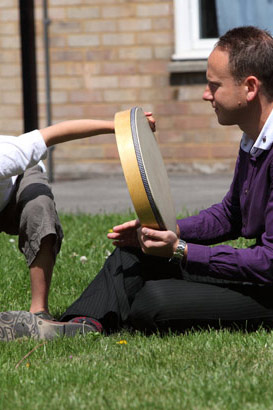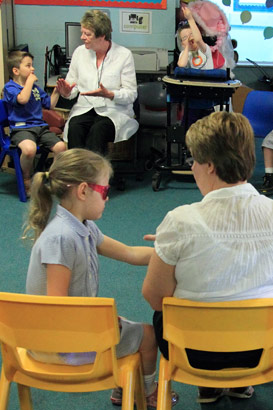
Parents are often the first to notice that their child is developing differently from other children. Professionals need
to listen attentively and respond to parents' concerns.
If professionals identify difficulties first, approaches to parents should be made tactfully and sensitively. They will need
to understand the need for formal assessment is necessary and how this can benefit the child (Howard, 2007).

Identification of children at risk of developmental delays and disorders needs to be based on regular and effective observations. Practitioners need an understanding of typical development, together with mindfulness of children's risk factors for developmental delay. This could be inherited or relate to environmental and life experience, such as:
- Premature/low-weight birth;
- Early development issues;
- Severe poverty;
- Parents' mental health;
- Parental lifestyle issues;
- Poor nutrition;
- Neglect/abuse.
The more risk issues a child experiences, the greater the chance of their developing a developmental delay.

Parental and/or professional concern about a child should result in screening.
Screening identifies children in need of further evaluation. A health professional will check whether the child can achieve
age appropriate tasks. If not, they are referred for further assessment.
Qualified health professionals will draw up in-depth developmental profiles for a child which will give information about
difficulties and advise interventions or treatments. It can involve informal and formal assessments and parent and professional
interviews.

A developmental assessment will seek to answer the following questions:
- Is the child's development typical for their age?
- If not, in which ways and to what degree is it atypical?
- What is the diagnosis?
- What might be the cause(s)?
- What needs to be done?
Professional assessment of children with SLD/PMLD/CLDD is important. Even if the disability itself cannot be treated, secondary difficulties need management and intervention to ensure the best possible health for the child; for example:
- Sensory impairments (vision, hearing, etc.)
- Communication difficulties
- Epilepsy
- Gastro-oesophageal reflux
- Drooling
- Constipation
- Spasticity
- Pain
- Postural needs
- Dental problems
- Behavioural and sleep difficulties
- Growth and endocrine disorders
(Horridge, 2010; Whiting, 2001)

Early identification of child health problems and developmental disabilities is essential, as without intervention, conditions can become more severe and disabling. Early identification can improve the quality of life and outcomes for the children and their families by:
- Preventing some disabilities;
- Reducing the impact and improving outcomes of the disability;
- Preventing secondary difficulties arising from the main disability;
- Leading to genetic advice and diagnostic testing for families;
- Ensuring that educational and health programmes are put in place which improve children's life course;
- Establishing support for families.
For more information, look at the Early Support Family Pack.

There are screening programmes for mothers and babies both before and after birth. During pregnancy, parents are also offered screening for Down's syndrome, and all newborn babies should be screened for:
- Hearing
- Medium Chain Acyl-CoA Dehydrogenase Deficiency (MCADD)
- Phenylketonuria
- Congenital hypothyroidism
- Sickle cell disorders
- Cystic fibrosis
(National Screening Committee, 2010; UK Newborn Screening Programme Centre, 2012)
Information sheets about these conditions are available from the following sites.
Climb [Children Living with Inherited Metabolic Diseases]

Following screening and assessment, children in need should be regularly monitored by health professionals. This is known
as 'surveillance'.
Baird et al (2001) describe surveillance as 'a parent-professional partnership that takes a broader look at [a child's]
developmental and behavioural skills and progress over time. It combines the observations of parents with the developmental
knowledge of the professional and...specific tests.'
Find out the strategies that your setting has in place for identifying additional disabilities and difficulties. Create a
bullet point list or flow chart showing what procedures and referrals are carried out, and how parents are told and supported.

Department for Education (2011) Support and Aspiration: A new approach to special educational needs and disability. Norwich: The Stationery Office.
Department for Education (2009) Early Identification, Assessment of Needs and Intervention - The Common Assessment Framework (CAF) for Children and Young People: A guide for practitioners. London: Department for Education.

Baird, G., Charman, T., Cox, A., Baron-Cohen, S., Swettenham, J., Wheelwright, S. and Drew, A. (2001) Screening and surveillance for autism and pervasive developmental disorders, Archives of Disease in Childhood, 84, 468-475.
Climb [Children Living with Inherited Metabolic Diseases] (2012) Why do we screen babies? Crewe: Climb.
Contact a Family (2009) About diagnosis: getting a diagnosis. In: Contact a Family (2009) About Diagnosis: An information pack for families with disabled children. London: Contact a Family.
Horridge, K.A. (2010) Assessment and investigation of the child with disordered development, Archives of Disease in Childhood, Education and Practice, 96, 9-20.

Whiting, K. (2001) Investigating the child with learning difficulty, Current Paediatrics, 11, 240-247.